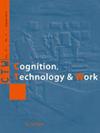为什么我们会遇到使用旧版本的oswestry残疾指数的研究?研究人员对版本更新和旧版本寿命的认识。
IF 3.4
3区 工程技术
Q2 ENGINEERING, INDUSTRIAL
引用次数: 0
摘要
Oswestry残疾指数(ODI)是一种用于评估脊柱疾病的常见结果测量方法,有三个正式更新的版本。然而,最近发表的一些文章仍然使用ODI-1.0。这表明开发人员和最终用户之间的信息流存在障碍。目的调查ODI最新版本的缺引文章,计算以前ODI版本的寿命,考察信息流是否存在阻塞。方法采用CNA和文本处理方法对spmc - pubmed引文数据集进行分析。结果本研究最重要的发现是,在引文可见性和全文访问限制方面,开发人员和用户之间的信息流没有障碍。在ODI-1.0和ODI-2.0文章之间确定了三个不同的子网。14%(165)的文章引用了ODI-1.0和ODI-2.0版本。新的ODI版本在文献中占据主导地位所需的时间限制在4到9年之间。结论ODI文献中存在引文缺失问题,这不是由于开发者和最终用户之间的信息流阻塞造成的。本文章由计算机程序翻译,如有差异,请以英文原文为准。
Why do we encounter studies with older versions of the oswestry disability index? Awareness of researchers about the version updates and the lifespan of older versions.
BACKGROUND
The Oswestry Disability Index (ODI) is a common outcome-measure used for assessment of spinal disorders with three officially updated versions. However, there are recently published articles that still use ODI-1.0. This suggests the existence of a block on information flow between developers and end-users.
OBJECTIVE
To investigate the articles with missing citation to the latest ODI version, to calculate the life span of previous ODI version and to investigate the existence of a block on information flow.
METHODS
PMC-PubMed citation dataset is analyzed by CNA and text processing methods.
RESULTS
The most important finding of this study is that there is no block on information flow between developers and users in terms of visibility in citations and full text access restrictions. Three different sub-networks are identified between ODI-1.0 and ODI-2.0 articles. 14% (165) of articles have citation to ODI-1.0 and ODI-2.0 version-articles. The time limit that is required for the new ODI version to become dominant in the literature is between 4 and 9 years.
CONCLUSION
There is a missing citation problem in the ODI literature which is not a result of a block on information flow between developers and end-users.
求助全文
通过发布文献求助,成功后即可免费获取论文全文。
去求助
来源期刊

Cognition Technology & Work
ENGINEERING, INDUSTRIAL-
CiteScore
6.90
自引率
7.70%
发文量
26
审稿时长
>12 weeks
期刊介绍:
Cognition, Technology & Work focuses on the practical issues of human interaction with technology within the context of work and, in particular, how human cognition affects, and is affected by, work and working conditions.
The aim is to publish research that normally resides on the borderline between people, technology, and organisations. Including how people use information technology, how experience and expertise develop through work, and how incidents and accidents are due to the interaction between individual, technical and organisational factors.
The target is thus the study of people at work from a cognitive systems engineering and socio-technical systems perspective.
The most relevant working contexts of interest to CTW are those where the impact of modern technologies on people at work is particularly important for the users involved as well as for the effects on the environment and plants. Modern society has come to depend on the safe and efficient functioning of a multitude of technological systems as diverse as industrial production, transportation, communication, supply of energy, information and materials, health and finance.
 求助内容:
求助内容: 应助结果提醒方式:
应助结果提醒方式:


